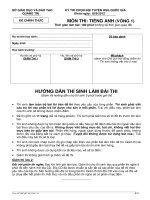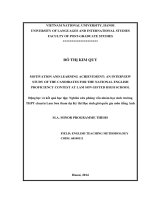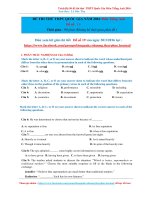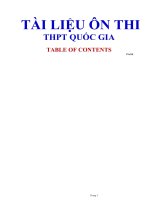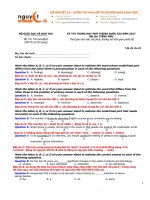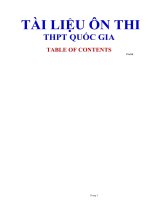Động lực và kết quả học tập Nghiên cứu phỏng vấn nhóm học sinh trường THPT chuyên Lam Sơn tham dự Kỳ thi Học sinh giỏi quốc gia môn tiếng Anh
Bạn đang xem bản rút gọn của tài liệu. Xem và tải ngay bản đầy đủ của tài liệu tại đây (497.11 KB, 59 trang )
VIETNAM NATIONAL UNIVERSITY, HANOI
UNIVERSITY OF LANGUAGES AND INTERNATIONAL STUDIES
FACULTY OF POST-GRADUATE STUDIES
********************
ĐỖ THỊ KIM QUY
MOTIVATION AND LEARNING ACHIEVEMENT: AN INTERVIEW
STUDY OF THE CANDIDATES FOR THE NATIONAL ENGLISH
PROFICIENCY CONTEST AT LAM SƠN GIFTED HIGH SCHOOL
Động lực và kết quả học tập: Nghiên cứu phỏng vấn nhóm học sinh trường
THPT chuyên Lam Sơn tham dự Kỳ thi Học sinh giỏi quốc gia môn tiếng Anh
M.A. MINOR PROGRAMME THESIS
FIELD: ENGLISH TEACHING METHODOLOGY
CODE: 60140111
Hanoi, 2014
VIETNAM NATIONAL UNIVERSITY, HANOI
UNIVERSITY OF LANGUAGES AND INTERNATIONAL STUDIES
FACULTY OF POST-GRADUATE STUDIES
********************
ĐỖ THỊ KIM QUY
MOTIVATION AND LEARNING ACHIEVEMENT: AN INTERVIEW
STUDY OF THE CANDIDATES FOR THE NATIONAL ENGLISH
PROFICIENCY CONTEST AT LAM SƠN GIFTED HIGH SCHOOL
Động lực và kết quả học tập: Nghiên cứu phỏng vấn nhóm học sinh trường
THPT chuyên Lam Sơn tham dự Kỳ thi Học sinh giỏi quốc gia môn tiếng Anh
M.A. MINOR PROGRAMME THESIS
FIELD: ENGLISH TEACHING METHODOLOGY
CODE: 60140111
SUPERVISOR: Dr. LÊ VĂN CANH
Hanoi, 2014
i
DECLARATION
I certify that the minor thesis entitled "Motivation and Learning
Achievement: An interview study of the Candidates for the National English
Proficiency Contest at Lam Son Gifted High School" and submitted in partial
fulfillment of the requirements for the degree of Master of Arts in TESOL is the
result of my work, except where otherwise acknowledged, and that this minor thesis
or any part of the same has not been submitted for a higher degree to any other
university or institution.
The research reported in this thesis was approved by National University,
Hanoi.
Signature
Do Thi Kim Quy
ii
ACKNOWLEDGEMENTS
First of all, I would like to express my sincere thanks and my deep gratitude
to my supervisor, Dr. Lê Văn Canh for his enlightening lectures in the Methodology
and Materials Development Courses, greatly enthusiastic guidance, encouragement,
and constructive comments in-depth along the way with my project, without which,
this thesis would not be able to be properly completed.
I am obliged to all the lecturers of the Faculty of Post Graduate Studies,
Hanoi University of Languages and International Studies, Vietnam National
University, whose instructions have laid the foundations for my work. I would also
like to express my special thanks to all the staff for their constant assistance while
my work was in process.
Finally, I owe a great debt to my family members, my friends and my
students who helped me fulfill my job as a daughter, a wife, a teacher, a learner and
a researcher.
Once again my sincere thanks to all.
iii
ABSTRACT
Motivation is crucial in learning a foreign language. It is believed to
determine one's success in mastering the target language. This study was conducted
in an attempt to explore the relationship between motivation and achievement in
learning English among the candidates for the National English Proficiency Contest
at Lam Son Gifted High School.
Narrative frames were employed, giving the students' in-depth insights into
English learning experiences. Face-to-face individual interviews were also carried
out to make a deeper understanding of their ideas about it. Through their elicited
learning experience, the more dominant motivational orientations among the
students were defined and the relationship between motivation and learning
achievement in foreign language learning was investigated.
The findings show that the students are both intrinsically and extrinsically
motivated to learn English, in which extrinsic orientation does bring out effective
achievement, being superior to intrinsic one and that their learning achievement is
positively related to motivation. The findings also help to offer recommendations
for those involved in pedagogical activities.
iv
TABLE OF CONTENTS
DECLARATION i
ACKNOWLEGEMENT ii
ABSTRACT iii
TABLE OF CONTENTS iv
PART A: INTRODUCTION 1
1. Rationale of the study 1
2. Research aims, objectives and research questions 1
3. Scope of the study 2
4. Significance of the study 2
5. Organization of the thesis 2
PART B: DEVELOPMENT 3
CHAPTER I: LITERATURE REVIEW 4
1.1. Motivation defined 4
1.2. Motivational orientations and their role in second language learning 5
1.2.1. Intrinsic versus extrinsic motivation 5
1.2.2. Instrumental versus integrative motivation 6
1.2.3. Norton's investment in second language learning 10
1.2.4 Dornyei's L2 Motivational Self System 11
1.2.5. The relationship between motivation and achievement 12
1.3. Previous studies on motivation and learning achievement 13
CHAPTER II: METHODOLOGY. 15
2.1. The English teaching context at Lam Son Gifted High School 15
2.2. An overview of the Candidates for the National English Proficiency
Contest 15
2.3. Research Design 16
2.3.1. Research Methodology 16
2.3.2 Participants 17
2.3.3. Instrument 17
v
2.3.3.1. Narrative frames 18
2.3.3.2. Interviews 19
2.4. Procedures of the study 19
CHAPTER III: FINDINGS AND DISCUSSION 21
3.1. Motivational orientations of the students selected for the National English
Proficiency Contest 21
3.1.1. Intrinsic Motivation 21
3.1.2. Extrinsic motivation 22
3.1.3. Changes in the students’ motivation 25
3.2. The influence of motivational orientations on the students’ learning
achievement 26
PART C: CONCLUSION AND RECOMMENDATIONS 33
1. Conclusion 33
1.1. Summary of the main findings 33
1.2. Concluding remarks 33
2. Implications 35
2.1. For teachers 35
2.2. For students 36
2.3. For parents 36
3. Limitations of the study 37
4. Suggestions for further study 37
REFERENCES 38
APPENDIX 1 - CÂU CHUYỆN HỌC TIẾNG ANH CỦA EM I
APPENDIX 2 - AN ENGLISH LEARNING STORY (TEMPLATE) III
APPENDIX 3 - CÂU CHUYỆN HỌC TIẾNG ANH CỦA EM IV
APPENDIX 4 - AN ENGLISH LEARNING STORY (SAMPLE) V
APPENDIX 5 - PHỎNG VẤN VIII
APPENDIX 6 - INTERVIEW (SAMPLE) X
1
PART A: INTRODUCTION
This part introduces the rationale of conducting this study, its aims and
objectives all well as its scope and significance. The part also presents the structure
of the thesis.
1. Rationale of the study
Motivation is one of the most important contributors to the success in
learning a foreign language. However, the relationship between students’
motivation and their learning achievement has not been concluded. In the school
where I have been teaching, which is called Lam Son Gifted High School, there are
students who have achieved well in terms of their English proficiency. These
students tend to be selected as candidates for the National Contest for the students
with the Highest Proficiency in English. However, there are students who have to
struggle with their English. The question is why, in the same learning context, there
are students who are more proficient than others? How does students’ motivation
affect their learning achievement? These questions inspire me to investigate the
relationship between the two variables: students’ motivation and their learning
achievement.
2. Research aims, objectives and research questions
The study is aimed at identifying the relationship between students’
motivation and their learning achievement so that suggestions on how to motivate
students can be made.
The objectives of the study are, thus,
- to define the dominant motivational orientations among students with a
high level of proficiency in English, and
- to explore the relationship between motivation and learning achievement.
2
In order to achieve the above aims and objectives, the study is designed to
seek answers to the following research questions:
1. What types of motivational orientations do the candidates for the
National English Proficiency Contest at Lam Son Gifted High School have
for learning English?
2. How is their learning achievement related to their motivational
orientations?
3. Scope of the study
This study is limited to the study of the correlation between the motivational
orientations of the students selected for the National English Proficiency Contest
and their learning achievement.
4. Significance of the study
Findings of this study will help to raise the importance of motivation among
teachers and students in mastering English. They also suggest pedagogical solutions
to the challenge of addressing the issue of maintaining passion for English and
improving the performance by English users/learners.
5. Organization of the thesis
The thesis is divided into 3 main parts: Introduction, Development and
Conclusion.
PART A is INTRODUCTION. This part gives the information about the
rationale of the study, the research objectives and research questions, the
significance, the scope. The relevant terms are also defined.
PART B, namely DEVELOPMENT, is divided into three chapters
Chapter 1 - Literature Review deals with theoretical framework, which
covers the issues related to motivation and learning achievement, the relationship
between them, if any. It also reviews previous studies on the topic.
3
Chapter 2 - Methodology presents the method used to analyze the
motivational factors. It also describes the setting, data collection instrument, data
collection procedure and data analysis.
Chapter C - Findings Analysis and Discussion presents the results from the
data collected and a discussion of the findings.
PART 3 is CONCLUSION AND RECOMMENDATIONS. This part
summarizes the findings, the conclusions, the teaching implications, the limitations
of the study as well as the suggestions for further study.
Summary:
This part introduces general details which serve as research background leading to
the formation of research needs. The impetus for the study is discussed prior to the
introduction of research aims, objectives and research questions, the scope and
significance of the study.
4
PART B: DEVELOPMENT
CHAPTER I: LITERATURE REVIEW
This chapter reviews the literature on motivation in second/ foreign language
learning. It starts with the definition of the concept of motivation. Then the
literature on the role of motivation in second/ foreign language learning as well as
the relationship between motivation and learning achievement will be reviewed,
too.
1.1. Motivation defined
Despite the unchallenged position of motivation in learning additional
languages, there is, in fact, no agreement on the exact definition of motivation.
Dornyei, (1998:117) comments, "Although motivation is a term frequently used in
both educational and research contexts, it is rather surprising how little agreement
there is in the literature with regard to the exact meaning of the concept".
The word "motivation" is derived from the Latin verb "movere", which
means to move (Pintrich and Schunk, 1996). To be motivated means to be moved to
do something. "The idea of movement is reflected in such commonsense ideas
about motivation as something that gets us going, keeps up moving and helps us get
jobs done."(p.3)
From a psychological point of view, Brown (1980:112) claims that
"motivation is commonly thought of as an inner driver, impulse, emotion or desire
that moves one to a particular action".
From the educational point of view, Ormrod (2000:472) state that
"motivation is something that energizes, directs and sustains behavior; it gets
students moving, points them in a particular direction, and keeps them going". In
the meantime, Pintrich and Schunk (1996:4) define motivation as "the process
whereby goal-directed activity is instigated and sustained". It can be seen that
motivation inevitably involves goals.
5
Masgoret and Gardner (2003:128) further propose: "The motivated
individual expends effort, is persistent and attentive to the task at hand, has goals,
desires, and aspirations, enjoys the activity, experiences reinforcement from success
and disappointment from failure, makes attributions concerning success and/or
failure, is aroused, and makes use of strategies to aid in achieving goals".
Cook (1991:97) simply says: "it has chiefly been used to refer to the long-
term fairly stable attitudes in the student's minds".
Gardner (1990) gives a detailed explanation and indentifies motivation in
foreign language learning to have three elements, including:
i. a desire to learn the language;
ii. effort expended towards learning the language;
iii. favorable attitudes towards learning the language.
In other words, motivation in learning a foreign language can be regarded as
a process in which a learner has desire, persistence and a positive attitude to
attaining the goal of learning the target language. It is characterized by long-term,
quality involvement in learning and commitment to the process of learning.
1.2. Motivational orientations and their role in second language learning
1.2.1. Intrinsic versus extrinsic motivation
Pintrich and Schunk (1996) define these two terms in the following ways:
"Intrinsic motivation refers to motivation to engage in an activity for its own sake.
People who are intrinsically motivated work on tasks because they find them
enjoyable. Task participation is its own reward and does not depend on explicit
rewards or other external constraints. In contrast, extrinsic motivation is motivation
to engage in an activity as a means to an end. Individuals who extrinsically
motivated work on tasks because they believe that participation will result in
desirable outcomes such as a reward, teacher praise or avoidance of punishment."
(pp. 257-258)
6
The phenomenon of intrinsic motivation was first acknowledged within
experimental studies of animal behavior, where it was discovered that many
organisms engage in exploratory, playful and curiosity-driven behaviors even in the
absence of reinforcement or reward (White, 1959).
In humans, intrinsic motivation is not the only form of motivation, or even of
volitional activity, but is is a pervasive and important one. From birth onward,
humans, in their healthiest states, are active, inquisitive, curious, and playful
creatures, displaying a ubiquitous readiness to learn and explore, and they do not
require extraneous incentives to do so.
Because intrinsic motivation exists in the nexus between a person and a task,
some authors have defined intrinsic motivation in terms of the task being interesting
while others have defined it in terms of the satisfactions a person gains from
intrinsically motivated task engagement.
Extrinsic motivation is a construct that pertains whenever an activity is done
in order to attain some separable outcomes. Extrinsic motivation thus contrasts with
intrinsic motivation, which refers to doing an activity simply for the enjoyment of
the activity itself, rather than its instrumental value.
Deci and Ryan's (1985:256) maintain that "being intrinsically motivated to
learn improves the quality of learning and that those conditions that are autonomy
supporting and informational will promote more effective learning as well as
enhanced intrinsic motivation and self-esteem." That is an individual with a high
level of intrinsic motivation is likely to demonstrate autonomy in his/her learning
and lead to a higher achievement. Sharing the same viewpoint, Gottfried (1985),
Deci and Ryan (1985) state that "extrinsic motivation is not as important as intrinsic
motivation in learning" and that "extrinsically oriented learners may tend to
attribute a poor performance to a lack of intelligence or ability (a stable and internal
factor). Intrinsically oriented learners may be more inclined to attribute a poor
performance to a variable or unstable factor like effort and this accept it as a
motivating challenge to try harder".
7
Pittan et al. (1983) propose when the primary concern of a learner is to
achieve an extrinsic goal, s/he will try to finish the task as quickly and with as little
effort and frustration as possible. Such a learning approach is unlikely to lead to
effective learning.
Brophy (1983) mentions that if we want students to engage in academic
activities seriously, it will be important to develop their intrinsic motivation in
learning. That is developing students' tendencies to value knowledge for its own
sake as well as enjoy the learning process and ultimately gain the personal benefit
that accrues from learning.
Figure 1 - Intrinsic and Extrinsic motivation
1.2.2. Instrumental and integrative motivation
Gardner and Lambert (1972:3) classify motivation into two main types,
namely instrumental and integrative motivation. He claims:
"The orientation is said to be instrumental in form of the purposes of
language study reflect the more utilitarian value of linguistic achievements, such as
getting ahead in one's occupation. In contrast, the orientation is integrative if the
INTRINSIC
Autonomy
Belonging
Curiosity
Love
Learning
Mastery
Meaning
EXTRINSIC
badges
competition
fear of failure
fear of punishment
money
points
rewards
8
student wishes to learn more about the other cultural community because he is
interested in it in an open-minded way, to the point of eventually being accepted as
a member of that other group."
To put it another way, a learner who learns with integrative motivation has a
genuine interest in the second language community. S/he wants to learn the
language in order to communicate with its members and take part in their culture.
On the other hand, a learner with instrumental motivation is more interested in how
the second language can be used to achieve some other goals, such as obtaining a
degree or a good job. This is learning the language for some practical reasons.
Instrumental motivation references the desire that language learners have to
learn a second language for utilitarian purposes, such employment, whereas
integrative motivation references the desire to learn a language to integrate
successfully with the target language community.
Regarding the impact of either of the two types on the learning achievement,
Gardner and Lambert hypothesize that "the integratively oriented learner might be
better motivated because the nature of his goals is more likely to sustain the long-
term effort needed to master a second language" (1972:16). From their studies of
the learners of French in Canada, they posit that a learner with an integrative motive
is likely to achieve better proficiency in language learning than an instrumental one.
This is because the integrative motive is considered rooted in the personality of the
learner. An integrative motive is superior to the instrumental one. Then, in fact,
Gardner and MacIntyre (1991) conclude that both integrative and instrumental
motivations can lead to language proficiency, but integratively motivated students
can learn more. This sound reasonable since someone who is oriented to learn a
language for integrative reasons might also recognize the instrumental value of
learning the language and vice versa.
As Ellis (2008:679) states, "integrative orientation was seen as a more
powerful predictor of achievement in formal learning situations than instrumental
orientation".
9
INTEGRATIVE MOTIVATION
From my own learning experience, I am of the opinion that very often a
foreign language learner probably possesses both of integrative and instrumental
motivations. This is due to fact that I really enjoy learning English as the
instrumental motive helps me develop my professional knowledge for teaching
while the integrative motive helps me communicate more satisfactorily in the
second language community. It seems that these two kinds of motivation are not
mutually exclusive.
Figure 2: A simple representation of the socio-educational model by Gardner
(2001)
The dotted square represents the borders of the integrative motivation
OTHER
SUPPORT
INTEGRATIVENESS
OTHER
FACTORS
MOTIVATION
ATTITUDES TOWARD
THE LEARNING
SITUATION
LANGUAGE
APTITUDE
LANGUAGE
ACHIEVMENT
10
1.2.3. Norton's investment in second language learning
Norton (1995) argues for a conception of investment rather than motivation
to capture the complex relationship of language learners to the target language and
their sometimes ambivalent desire to speak it. "The notion of investment conceives
of the language learner, not as ahistorical and unidimensional, but as having a
complex social history and multiple desires. In her view, the conceptions of
motivation, which are dominant in the filed of SLA, do not "capture the complex
relationship between relations of power, identity, and language learning", so "the
conception of investment rather than motivation more accurately signals the socially
and historically constructed relationship" of the people involved.
She is in favor of the term "capital". She explains that if students invest in a
second language, they do so with the understanding that they will acquire a wider
range of symbolic and material resources, which will in turn increase the value of
their cultural capital. Learners will expect or hope to have a good return on that
investment - a return that will give them access to hitherto unattainable resources.
It is important to note that the notion of investment she is advocating is not
equivalent to instrumental motivation since "the conception of instrumental
motivation generally presupposes a unitary, fixed and ahistorical language learner
who desires access to material resources that are the privilege of target language
speakers". In this line, motivation is a property of the language learner - a fixed
personality trait. "The notion of investment, on the other hand, attempts to capture
the relationship of the language learner to the changing social world. It conceives of
the language learner as having a complex social identity and multiple desires. The
notion presupposes that when language learners speak, they are not only exchanging
information with target language speakers but they are constantly organizing and
reorganizing a sense of who they are and how they relate to the social world. Thus
an investment in the target language is also an investment in a learner's own social
identity, an identity which is constantly changing across time and space.
11
1.2.4 Dornyei's Second Language Motivational Self System
Dornyei (1990) has described a major theoretical shift that has been
transforming the landscape of motivation research: the move from the traditional
conceptualization of motivation in terms of an integrative/instrumental dichotomy
to the recent re-conceptualization of motivation as being part of the learner's self
system, called "The Second Language (L2) Motivation Self System". From his
perspective, the L2 Motivational Self System comprises three elements: The Ideal
L2 Self, the Ought-to L2 Self and the L2 Learning Experience.
Ideal L2 Self is the L2-specific facet of one's ideal self. It is based on the
individual aspirations and goals as a language learner. If the person we would like
to become speaks an L2, the 'ideal L2 self' is a powerful motivator to learn the L2
because of the desire to reduce the discrepancy between our actual and ideal selves.
Traditional integrative and internalized instrumental motives would typically belong
to this component.
Ought-to L2 Self is is a product of the individual's perceived obligations and
responsibilities as a language learner. It is concerned about "the attributes that one
believes one ought to possess to meet expectations and to avoid possible negative
outcomes". This dimension corresponds to the more extrinsic (i.e. less internalized)
types of instrumental motives.
L2 Learning Experience is derived from the learning environment and
learners' perceptions of their previous language learning successes and failures. It
deals with "situated, executive motives related to the immediate learning
environment and experience (e.g. the impact of the teacher, the curriculum, the peer
group, the experience of success).
This new model by Dornyei does not conflict with Gardner's original highly
influential concept of "Integrative motivation" but provides a "broader frame of
reference" to account for the motivation of learners that do not have direct contact
with speakers of the target language. In other words, the theory proposed a system
12
that explicitly focuses on aspects of the individual's self is compatible with the
whole-person perspective of past theorizing.
1.2.5. The relationship between motivation and achievement
The findings of much research show that motivational factors are certainly
related to second or foreign language learning. Gardner, 1985; Ramage, 1990). Thus
motivation should be regarded as one of the key factors in successful language
learning. This is because achievement is very much dependent on the effort that a
learner expends in the task of learning a foreign language.
Hawley (1972:2) defines the achievement motive as "the need to attain a
standard of excellence, or to accomplish a goal in order to prove one's worth".
When people have a need to achieve, they have a high attitude towards success and
work hard to ensure they are successful. If they are intrinsically motivated, they
participate in the activity for the sake of learning or improvement. If they are
extrinsically motivated, they participate in the activity with the expectation of
rewards. In a word, learners' willingness and perseverance to learn a language are
closely linked to their achievement needs. McClelland (1985) states that
achievement motivation is based on a desire to excel. That means it is the tendency
to strive for excellence or success. Achievement motivated people to have a need to
achieve and be successful at whatever they attempt. According to Dornyei (1990)
the need for achievement plays a major role in the motivational factors of foreign
language learning.
Ellis (1994:515) maintains that "the relationship between motivation and
achievement is an interactive one". This is to say that a high level of motivation
does contribute to learning and that success can help to maintain or even enhance
the existing motivation. Conversely, a vicious circle of low motivation will result in
low achievement that further lower the motivation in learning.
Research findings do suggest, therefore, that there is a circular cause and
effect relationship between motivation and achievement in second language
13
learning (Lightbown and Spada, 1993). In other words, the more one succeeds, the
greater one's motivation; the greater one's motivation, the more one succeeds.
1.3. Previous studies on motivation and learning achievement.
From the second language acquisition perspective, there have been a host of
studies on the relationship between motivation and learning achievement, some of
which are as follows.
The study conducted by Yu Yuanfang - Dalian University (2009)
investigates Australian students learning Chinese as a foreign language and Chinese
students learning English as a foreign language. Its findings show that Chinese
university students were more instrumentally motivated than their Australian
counterparts while Australian university students were more integrative motivated
than their Chinese counterparts in foreign language learning.
The research named "Second language learning success and motivation"
(2009) by Ali Osman Engin deals with three dimensions of motivation: integrative
motivation, instrumental motivation and work avoidance motivation. After the
research, he concludes that "there is a close relationship between the students'
success and instrumental motivation. However, instrumental motivation is not as
effective as integrative motivation for second language learning success. He also
highlights that "The more integrative and instrumental motivation a person has, the
less likely he or she is to experience work avoidance motivation" and that "the
success or the students and work avoidance are negatively correlated".
Numerous research studies have shown that intrinsically motivated students
have higher achievement levels, lowers level of anxiety and higher perceptions of
competence and engagement in learning than students who are not intrinsically
motivated (Wigfield&Eccles, 2002; Wigfield&Waguer, 2005). These studies
demonstrate that there is a positive correlation between intrinsic motivation and
academic achievement.
14
Contrary to what have been mentioned, the study carried out by Kazuyo
Taguchi, from School of International Studies, University of South Australia (2006)
on sixty-one 10 graders, aged 14-16 and four teachers in South Australia does not
support the expected relationship between motivation and academic gains
(achievement). In other words, it reveals that motivation and academic gains are not
significantly correlated (p.567). This may be due to the complex mixture of factors
described by different motivational theories and language learning process.
15
CHAPTER II: METHODOLOGY
The aim of this study was to identify the motivational factors in enabling the
candidates for the National English Proficiency Contest to persist in the process of
English learning and the relationship of motivation and their achievement. Some
information about my workplace and working conditions should be briefly
described.
2.1. The English teaching context at Lam Son Gifted High School
Since Vietnam's open-door policy in 1986 and its participation into the
WTO; under the pressure of globalization and the demand for integration, the
number of English learners in Vietnam is on vast increase. English is taught at most
private and state-owned secondary and high schools.
English is a compulsory subject at Lam Son Gifted High School. In fact, in
order to become a member of Lam Son Gifted High School, since 2011, students
have been under obligation to pass the 60-minute English test which mainly focuses
on grammar. For those wishing to become members of English specializing classes,
they have to take another English written test which deals with 80 questions in 150
minutes. These two tests do not include speaking and listening. Therefore, students'
level of English may be said to be satisfactory enough in terms of grammar, but not
productive skills.
2.2. An overview of the candidates for the National English Proficiency
Contest
Lam Son Gifted High School is one of the best schools in Vietnam. It is
considered the place bearing the responsibility for training talented human resources
provincially and nationally. For many years, students from the school have been
participating in a lot of contests nationwide and worldwide and have won a lot of
medals including gold, silver and bronze. Lam Son English Selected Team for the
National English Proficiency Contest consists of 8 members, to be one of whom,
16
one is obliged to go in for 2 examinations, one at school level, and the other at
provincial level. The candidates go through spoken and written tests. Unfortunately,
the listening skill is not tested and the test is a little different from the national test
as regards structure.
The National English Proficiency takes place in January or February
annually and the results are usually announced in late February or early March. The
candidates for this Contest have to take the test covering the four skills, namely
listening, reading, writing and speaking. The Contest lasts two days, one for the first
3 skills and the other for the fourth.
Usually, 6 out of 8 candidates win the prize each year, accounting for 80 per
cent of the total number. However, they often get the 3rd or the 4th prize,
sometimes the 2nd. This is considered an unsatisfactory result by local authority.
As a teacher of English, who takes in charge of the selected team, I am much
concerned about how to improve performances and learning achievement of the
students participating in the National English Proficiency Contest. In this review,
motivation serves a prerequisite. It is believed that once students have a passion for
English, or are highly motivated, whatever reason it is, they are bound to devote and
apply themselves to it.
2.3. Research Design
2.3.1. Research Methodology
The selection of an appropriate research method is fundamental to any
research design. In this study, the qualitative method is employed. It is said that
qualitative studies "seek to collect rich data by making interconnections between
points, often assigning meaning to the data after collection has occurred and often,
though not always, eschewing the quantification of this data." (Tamara Swenson,
442). In other words, they seek to identify and interpret precisely the here-and-now
experience of the individual or the group being studied.
17
2.3.2 Participants
Eights students taking part in the National Proficiency Contest, Academic
Year 2013-2014 were involved in the study, four of whom were twelfth graders and
the other four eleventh graders. The 8 selected students were asked to tell about
their stories of learning English by filling the missing information based on their
own experiences.
6 out of 8 candidates succeeded in winning the prizes, 3 of whom got the 3rd
and three others got the 4th.
The 8 participants were categorized into 3 levels based on the results of the
National English Proficiency Contest 2014 as follows:
i. the high achievers - HA (3 participants winning the 3rd prizes)
ii. the average achievers - AA (3 participants winning the 4th prizes)
iii. the low achievers - LA (2 participants failing to win the prize)
To ensure the students' personal confidentiality, students' were assigned by
symbols. For example, HA1 means High Achiever 1.
2.3.3. Instrument
Narrative frames, initiated by Barkhuizen & Wette (2008) were employed to
elicit the students' English learning experiences in order to find out the types of
motivation stimulating students to study English and work out the relationship
between motivation and learning achievement since they bear a lot of advantages.
As Barnard, R., & Viet, G.N. (2010: 79) claimed: "A narrative frame is similar to a
semi-structure interview, which allows the participant to expand upon the points
posed by the researcher. However, participants have more freedom to divulge
information in frames than may be possible in an interview, where avoiding or side-
stepping potentially face-threatening questions can be difficult. Moreover, unlike
conventional interviews, completing these frames in their own time and place
allows participants to reflect more fully on issues."
18
It also should be noted that certain interview questions were given to
students in relation to the missing and required information, aiming at combining
the advantages of both, the emerging information was subsequently triangulated
with data from other procedures.
In sum, my study investigates the motivation of learning a foreign language
using narrative frames first, which are one kind of in-depth interview, then followed
by individual face-to-face interviews. This can provide a better understanding of
students for the sake of the findings. In this respect, the study incorporated two
types of data collection: narratives frames and face-to-face interviews. The reason
for this method was that it was more appropriate and feasible than using other
research methods.
So as to make it easier for students to give the most possible accurate and
heart-felt answers, the questions were given in the mother tongue, i.e. Vietnamese.
Students were given the appropriate time to have thorough thoughts and think the
issue over. Then their stories were transcribed and analyzed.
2.3.3.1. Narrative frames
The narrative frame is designed in a form of story telling. The students were
asked to write two open-ended frames. The following is an English translation of
example frames.
1. I started learning English
I chose to study English because
When I started learning it, I
because I felt it
because
Regarding the role of my family members in my English learning, I can
say that
